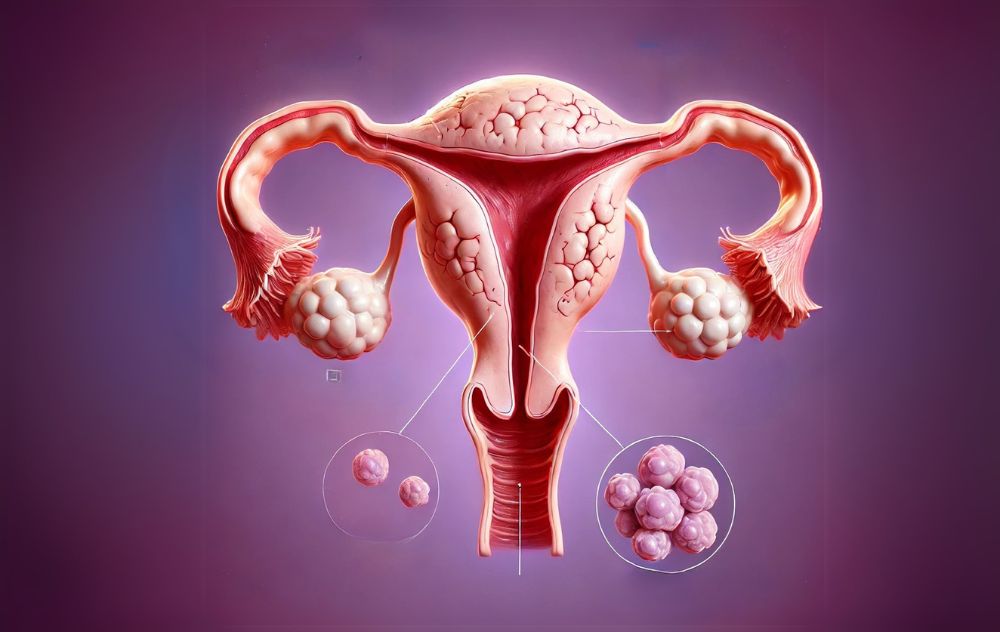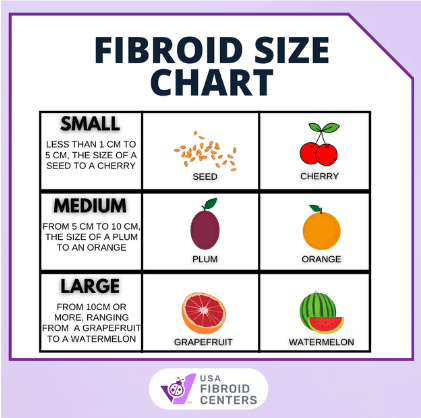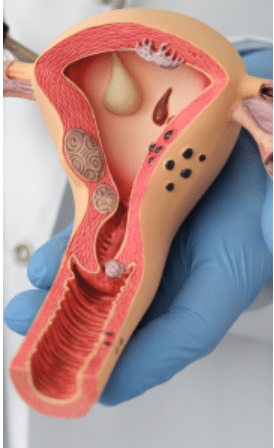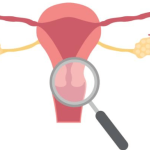
Have you heard of uterine fibroids but aren’t sure what a large fibroid means? These noncancerous growths in the uterus can vary greatly in size. While many women experience no symptoms from small fibroids, large fibroids, typically exceeding 5 centimeters (about 2 inches) in diameter, can significantly impact daily life.
While fibroids can vary in size, those classified as large may cause noticeable symptoms such as heavy menstrual bleeding, pelvic pain or pressure, frequent urination, and even reproductive issues.
Fibroids may begin developing quickly, then slow down and speed up at different intervals. This is often seen when fibroid symptoms decrease for a few weeks before worsening. Over time, some fibroids grow larger and cause additional problems, so it’s important not to disregard your symptoms, especially as they may overlap with other conditions.
Causes of Large Fibroids
The exact cause of fibroids is unknown. Research has shown several factors may influence whether you will get fibroids and how large they can grow.
The risk of developing fibroids increases with age, especially between puberty and menopause. The risk begins decreasing as you approach menopause because of hormone reduction. Genetics also plays a role in fibroids. If you have a family member with fibroids, you have an increased risk of developing them. Race may also affect fibroid development. African American women are two to three times more likely to be diagnosed with uterine fibroids than Caucasian women. However, women of Asian descent (particularly those with Chinese ethnicity) are also known to have a higher risk.
It is believed estrogen can cause fibroids to continue growing until they are large enough to outgrow the blood supply. Researchers are also examining other lifestyle habits to determine their role in developing fibroids, such as eating red meat frequently, vitamin D deficiency, and obesity.
How Big Can Fibroids Get?
Fibroids range from as small as a seed to as large as a melon and can also develop in multiple clusters. A single fibroid may be less than an inch, but groups and clusters of fibroids can be much larger. Depending on a fibroid’s size and location, they can affect different parts of your body, such as expanding the uterus to impact other organs or blocking the fallopian tubes, which may cause difficulty conceiving.
What is a Large Fibroid Size?
A fibroid is considered large when it reaches a significant size, typically exceeding 5 centimeters (about 2 inches) or more in diameter. However, the term “large” can be somewhat subjective, as the impact of fibroid size on a person’s health and symptoms may vary.
The impact of fibroids can vary greatly. A fibroid as small as 5 centimeters in diameter can cause significant discomfort and require medical attention, while others may experience little to no symptoms with larger fibroids. Our fibroid specialists can diagnose and treat large fibroids by providing personalized guidance on the appropriate course of action.
What is the Average Weight of a Large Fibroid?
In 2018, doctors in Singapore successfully removed a so-called giant uterine fibroid weighing about 61 lbs. (28 kilograms) from a 53-year-old woman’s abdomen, according to a new report of the case.¹ However, this is an extremely rare case of a large fibroid.
Typically, fibroids can weigh a few pounds, which can negatively impact surrounding organs and the body. The weight can put significant stress on the uterus, especially if it’s an intramural fibroid which is the most common type.
Uterine Fibroid Sizes
There are three different fibroid size categories:
- Small Fibroids can be less than 1 cm to 5 cm (.39 to 1.96 inches), the size of a seed to a cherry.
- Medium Fibroids range from 5 cm to 10 cm (1.96 to 3.93 inches), the size of a plum to an orange.
- Large Fibroids can be 10 cm (3.9 inches) or more, ranging from the size of a grapefruit to a watermelon.
Generally, when it comes to fibroid size, there isn’t a “normal size,” and that size alone won’t impact the severity of your fibroid symptoms in case you are wondering what size of fibroid is dangerous.

Request a consultation with a fibroid specialist
Uterine Fibroid Health Risks
Large and medium-sized fibroids can impact surrounding organs by enlarging the abdominal area. This increase can cause frequent urination, difficulty emptying the bladder, or constipation. Since the uterus sits very close to the rectum and bladder, medium- to large-sized fibroids may apply pressure on these organs. It isn’t inherently dangerous but can lead to uncomfortable or painful symptoms.

Which Size of Fibroid is Dangerous?
If large fibroids (those over 10 cm) are left untreated, they may grow even larger and potentially rupture or degenerate. Large fibroids can distort your uterus’ shape and cause damage to surrounding organs, such as your bladder and bowel. In some cases, large fibroids can also impact fertility. We typically recommend removing this size of fibroid.
Any fibroid size can eventually cause problems. If left untreated, fibroid symptoms can worsen over time.
Treating fibroids early on is important because they affect your physical and mental health. Fibroid symptoms like heavy bleeding, frequent urination, pain during sex, fatigue caused by anemia, pelvic pain, etc., can negatively impact your life.
If heavy, prolonged periods or any other symptoms take control over your decisions, it’s time to seek treatment.
Request a consultation with a fibroid specialist
Does a Large Uterine Fibroid Make My Stomach Look Bigger?
Without a proper diagnosis by a fibroid specialist, it is difficult to determine the size of your fibroid. Sometimes a large uterine fibroid may make the abdominal or belly area protrude outwards, similar to pregnancy.
The location of uterine fibroids is another factor that can cause your stomach to bulge.
Subserosal fibroids grow outside of the uterus, where they can press against other organs. They can also cause bloating, which can make your stomach look bigger.
If you want a definite answer, you should schedule an appointment for a diagnosis with a fibroid specialist. Your doctor will use an ultrasound or magnetic resonance imaging (MRI) to diagnose your fibroids. Once diagnosed, they will work with you to create a treatment plan. If you know you have a large fibroid and are experiencing worsening symptoms, it’s time to schedule an appointment.
What Size Fibroids Need Surgery?
Although many believe that hysterectomy is their only option, you may be surprised to learn that the best treatment for large fibroids is often a minimally invasive approach.
Uterine fibroid embolization or UFE is a non-surgical, office-based procedure to treat large and multiple fibroids. UFE works by targeting the fibroids’ nutritional and blood source: the artery. Embolic agents flow through a catheter to the fibroid and block the opening. Once the blood flow is blocked, the fibroid will naturally shrink and die. Since the embolic agents permanently stay inside the artery, it is highly unlikely that fibroid will reoccur.
How to Treat a Large Uterine Fibroid
Not all fibroid treatments work the same, especially for large fibroids. For instance, a hysteroscopic myomectomy is best suited to small fibroids that are located inside the uterus. An abdominal myomectomy can treat large fibroids, but this is considered major surgery with general anesthesia.
Uterine fibroid embolization (UFE), also known as uterine artery embolization, is a minimally invasive procedure for treating fibroids of all sizes. It requires less recovery time than other options and is less risky than surgery. This treatment stops the nutrients from reaching the fibroid, allowing it to shrink and die.

Visit USA Fibroid Centers and Connect with a Specialist
At USA Fibroid Centers, treating your fibroid symptoms is even easier with our minimally invasive treatment. We have multiple locations across the USA to help you get the relief you need regardless of the size of the fibroids.
Contact us at 855.615.2555 to schedule a consultation and determine if UFE treatment suits you.
Source
Poh Ting Lim et al., “Management of a Giant Uterine Leiomyoma,” BMJ Case Reports, September 4, 2018.



